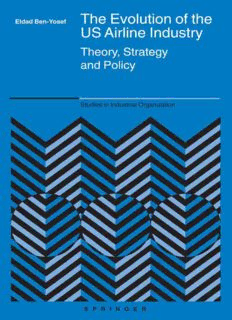
The Evolution of the Us Airline Industry: Theory, Strategy and Policy (Studies in Industrial Organization) PDF
Preview The Evolution of the Us Airline Industry: Theory, Strategy and Policy (Studies in Industrial Organization)
The Evolution of the US Airline Industry Studies in Industrial Organization Volume 25 Series Editors: H.W. de Jong,University of Amsterdam;Nijenrode, theNetherlands School of Business, Breukelen, the Netherlands W.G.Shepherd,Dept.of Economics, University of Massachusetts at Amherst, USA The titles published in this series are listed at the end of this volume. The Evolution of the US Airline Industry Theory, Strategy and Policy by Eldad Ben-Yosef A C.I.P.Catalogue record for this book is available from the Library of Congress. ISBN 0-387-24213-9 (HB) ISBN 0-387-24242-2 (e-book) Published by Springer, P.O.Box 17, 3300 AADordrecht, The Netherlands. Printed on acid-free paper All Rights Reserved © 2005 Springer No part of this work may be reproduced, stored in a retrieval system, or transmitted in any form or by any means, electronic, mechanical, photocopying, microfilming, recording or otherwise, without written permission from the Publisher, with the exception of any material supplied specifically for the purpose of being entered and executed on a computer system, for exclusive use by the purchaser of the work. Printed in the Netherlands. V CONTENTS Foreword ix Introduction 1 Overview 9 PART 1: ECONOMIC DEREGULATION 21 Deregulation 23 Aircraft 65 Destructive Competition 103 PART 2: NOISE AND SAFETY REGULATION 127 Social Regulation 129 Noise Regulation 137 Safety Regulation 169 PART 3: COMPETITION 211 Yield Management 213 What Next? 239 On Theory and Policy Implications 261 Epilogue 283 References 289 Index 293 vi List of Figures Figure 1. SimmmpleHuubNetwork................................................................................ 43 Figure 2. A Two-StarrNetttwork................................................................................ 47 Figure 3. End-to-EndVertical Integration............................................................... 49 Figure 4.US AirlinesFuel PriceIndeeex.................................................................... 72 Figure 5. NewAircraftOrders................................................................................. 79 Figure 6.ProfittMargins.......................................................................................... 87 Figure 7. Stage II Aircraft—Ratioby Airline—Year-Endd1989.............................. 88 Figure 8. Rate of Changein Aircraft Acquisition Cost........................................... 89 Figure 9. NewAircraftDeliveries 1985 –1993....................................................... 96 Figure 10. World AirlinesNet Profits1985–1995.................................................... 96 Figure 11. USAirlines AircraftCost Index 1986-1988.......................................... 100 Figure 12. New AircraftOrdersand Deliveries 1960-1998.................................... 124 Figure 13. PrimaryCauses of MajorAccidentsWorld Fleet 1980-1989............... 190 Figure14.Fatal Accidents By Tyyype World Fleet1988 -1995................................ 191 Figure 15. Accident/100,000 Departures 1990-1998.............................................. 196 Figure 16. Annual Profits 1990-2002..................................................................... 233 Figure17.Domestic and SystemmNetProfitMargins (Quarterly) 1996-2003........ 234 Figure18. RealYield (cents) 1990–2001............................................................... 234 Figure 19. CommmpositeCost Index1990-2001......................................................... 235 Figure 20.CostAllocation 2003............................................................................. 251 Figure21. LaaborrCostIndex................................................................................... 252 Figure 22. IncreaseinLaaborrCostperAvailableSeatMile, 1998-2001................. 252 Figure23. Laaborr Cost perrAvailableSeat-Mile(cents) 2001................................. 254 List of Tables Table1.Operating Data 1st Versus 2nd Generation Aircraft............................................ 73 Table2.AircrafttMarkettValueand Rental Rates............................................................ 74 Table3. Selected Aircraft Operating Costs 1994............................................................. 99 Table4.Selectedd AirlinesOperating Costs..................................................................... 99 Table5.US Carrrriers: Fatalities,SeriouslyInjured Passengers and Hull Loss 1982-1999... 177 Table6. TransportationnFatalities................................................................................ 178 Table7. Accident Causes - a Simple Typology............................................................. 183 vii In memory of Asher Ben-Yosef, myfather and Amos Ginor, my mentor Aviation Pioneers ix FOREWORD For over three decades the airline industry has continued to maintain a high profile in the public mind and in public policy interest. This high profile is probably not surprising. There does seem to be something inherently newsworthy about airplanes and the people and companies that fly them. The industry was one of the first major industries in the United States to undergo deregulation, in 1978. It thereby transitioned from a closely regulated sector (the former Civil Aeronautics Board tightly controlled everyttthing from prices to routes to entry) to one that is largely market oriented. The incumbent carriers transformed themselves from the point-to-point operators that the CAB had required to the hub-and-spokes structures that took better advantage of their network characteristics. Further, they transformed their pricing from the quite simple structures that the CAB had required to the highly differentiated/segmented pricing structures (“yield management”) that reached an apogee in the late 1990s. Some caaarriers, like American, Delta, and United, were better at this transition; others, like Pan American, TWA, and Eastern, were not. What the incumbent carriers did not do, however, was deal with their costly wage and work rules structures, which were an enduring legacy of their regulatory period. This legacy, when combined with the high-fare end of the yield-management pricing structure, has made them vulnerable to entry by new carriers with lower cost structures. This vulnerability—compounded byy high variability in fuel prices—has yielded large x and widespread losses since 2001, immersion in bankruptcy proceedings for some carriers, and work forces that (understandably) have been slow to yield the gains of the regulated era and are unhappy in having to do so. The public policy concerns continue. Eldad Ben-Yosef has written an intriguing book about the modern airline industry. He offers a unique perspective, being able to combine the expertise of a trained economist with the experience of someone who has been involved in the business of the industry for over 20 years. Though some readers may not agree with some points, his positions are definitely well-reasoned and worthy of serious consideration or debate. Readers will surely find the journey through this book to be interesting and worthwhile. Lawrence J. White Stern School of Business, New York University November 2004
Description: